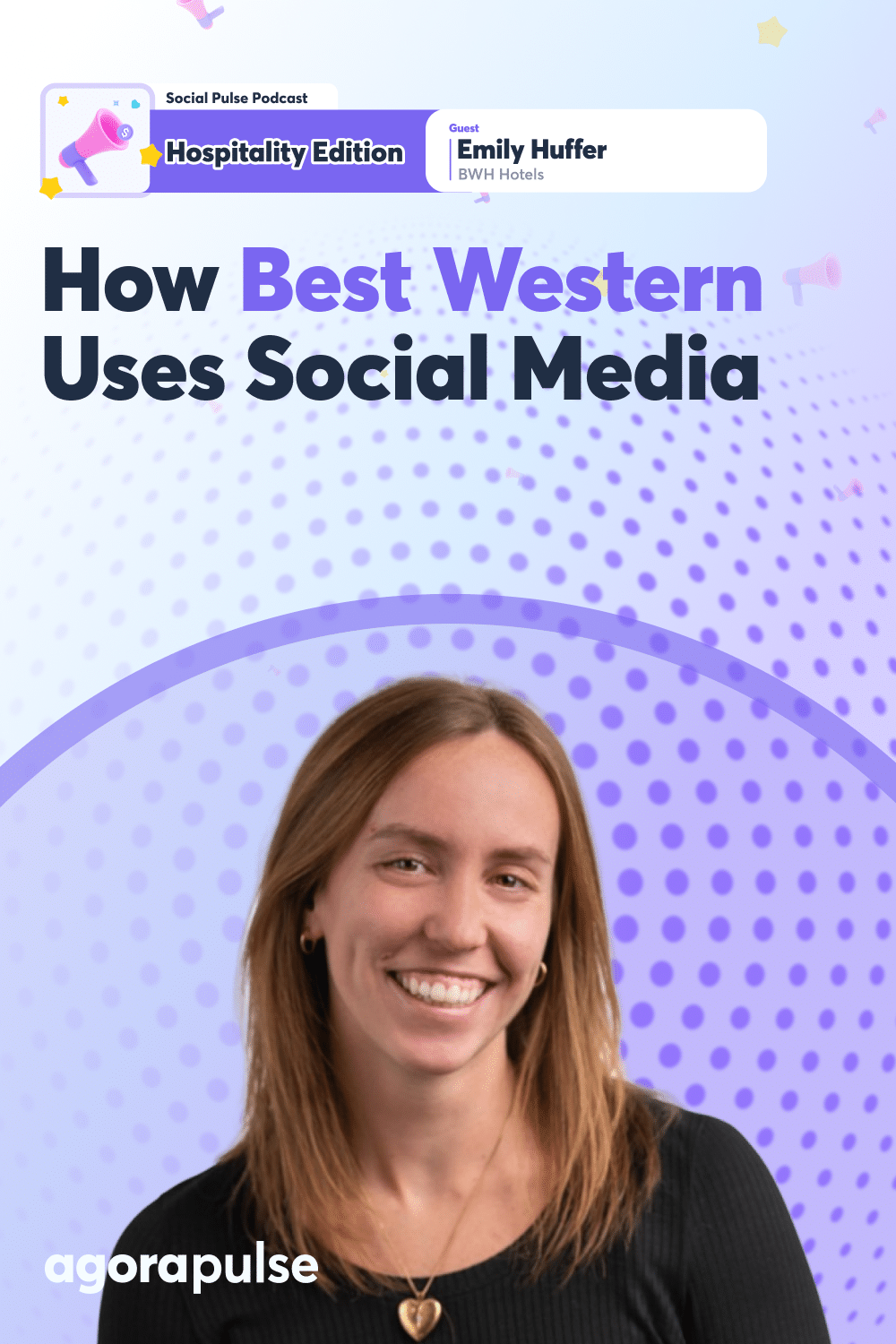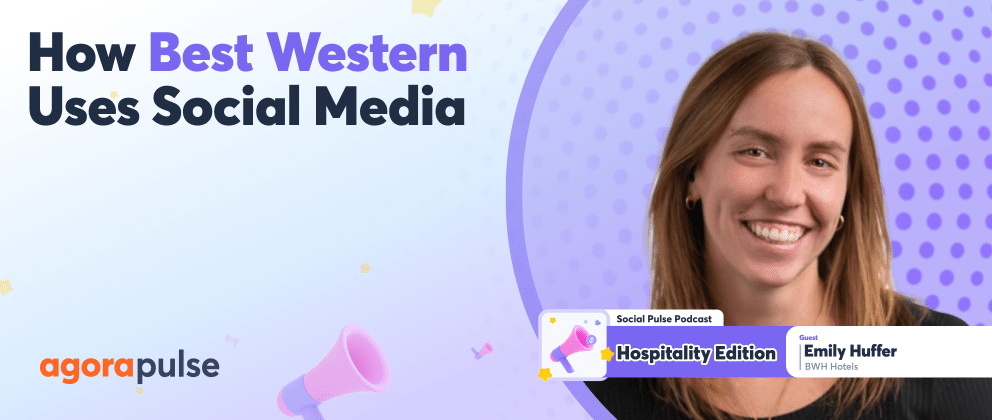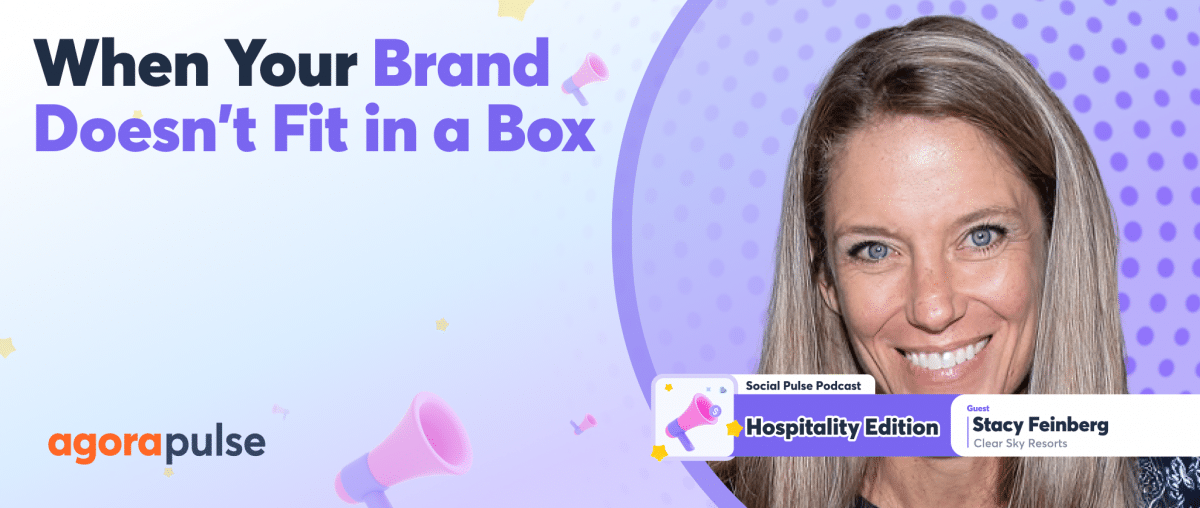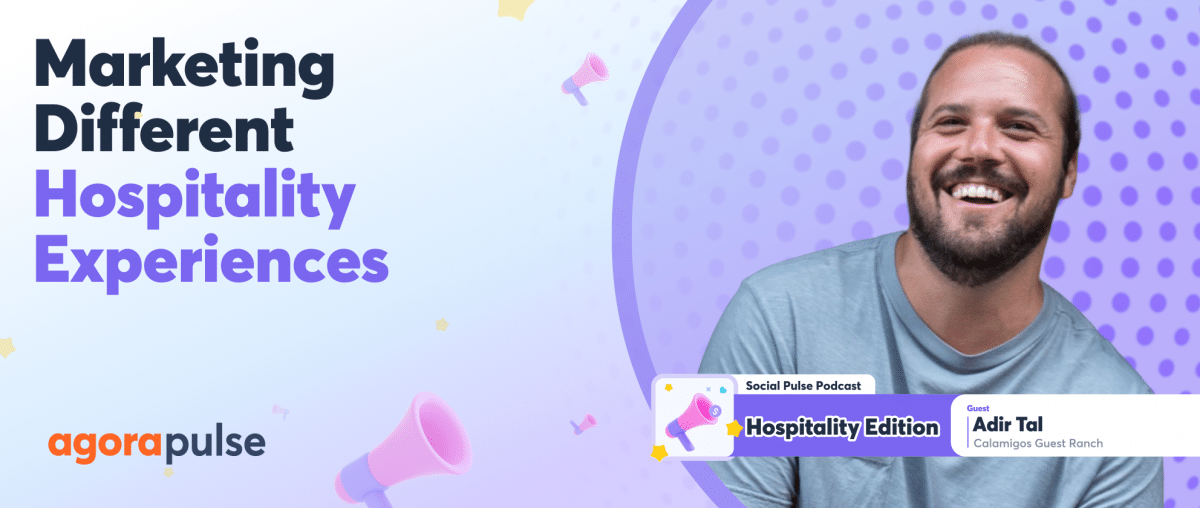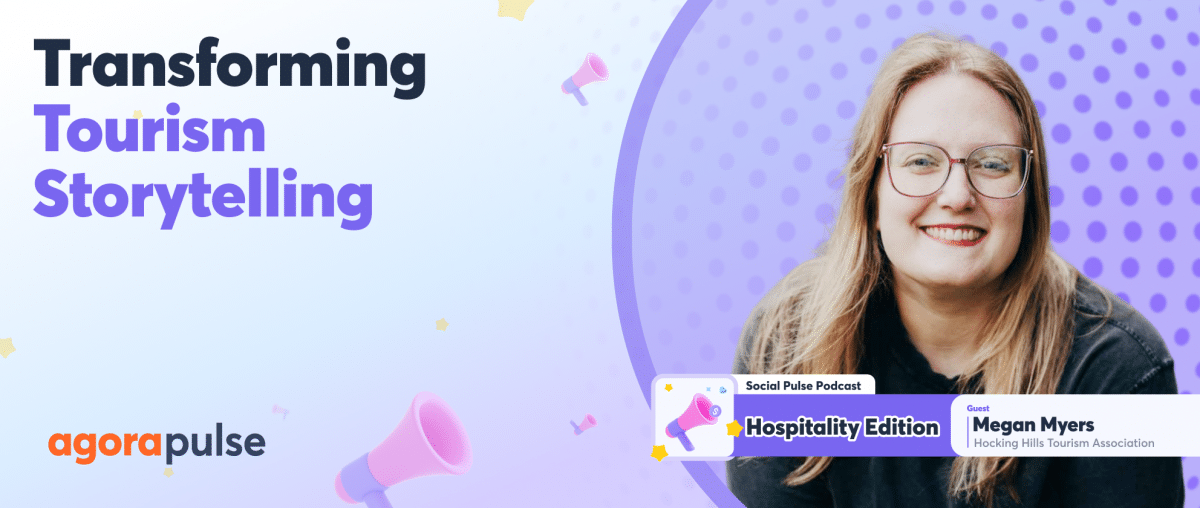When was the last time you made a snap judgment about a hotel brand based on what you thought you knew about them from years ago or dismissed a property because of outdated perceptions? Changing those perceptions isn’t just about renovating properties or updating logos. It’s about strategically reshaping your brand story through social media. And that’s exactly the challenge that Best Western Hotels and Resorts has been tackling head-on.
Our Social Pulse Podcast: Hospitality Edition guest Emily Huffer joins Agorapulse’s Chief Storyteller Mike Allton. As the social media manager at BWH Hotels, Emily is leading the charge and modernizing Best Western’s brand perception through innovative social media strategies, greater partnerships, and authentic storytelling with their background, digital marketing, and passion for building genuine community connections.
[Listen to the full episode below, or read along for the transcript of the Social Pulse: Hospitality Edition, powered by Agorapulse. Try it for free today.]
Challenges With Hotel Brand Perception
Mike Allton: So glad that you could be here and help us kind of understand what’s been going on with Best Western and how many other brands in the hotel industry and elsewhere might benefit.
Can you paint a picture of the brand perception challenges that Best Western was facing when you joined the team?
Emily Huffer: I can definitely do that. I don’t know if there was a very particular challenge that they were hiring me for. But I think our biggest challenge is just letting people know that Best Western isn’t the same Best Western as it was 50 years ago. We’ve always been known for being the convenient, affordable option, no matter where you are—we are literally all over the place. And we don’t want to alienate the guests who fall into that category. Like, we still need that. We still love our guests and those who love Best Western, but our portfolio has just grown so much. Also, we have luxury brands, boutique options, and soft brands, so we truly have something for everyone, no matter the style of your travels and what you’re looking for. And so that is what we have been pushing for to change the perception that we’re not the roadside motel anymore. Like, we have something for everyone.
And so that is something that we are just continuously trying to educate people on and something that we’re doing at the forefront on social media.
What was your initial strategy for beginning that shift in perception?
Emily Huffer: I think we just had this realization that at the end of the day, people aren’t necessarily choosing Best Western to stay in their hotel room, right? We instead developed a campaign around the idea that Best Western is more the bridge that gets you to your adventure.
That’s what we want to do.
We want to help you get to your adventure and explore new places, see new things, and try new experiences. So help us convey this brand story organically on social. We have a very large influencer marketing strategy. We work with a lot of creators. So that’s a big part of my day-to-day. I mean, we have over 4,000 hotels globally. And while I think that I can create great content, I can’t visit all of these hotels. That’s where our creators have been such a huge, huge help for us. So we talked to influencers who have specific stories or they’re going to specific places, and it’s the perfect way that we can integrate this brand story of being the bridge to your adventure and to integrate our brand in an authentic way with audiences who are already super engaged with these creators.
So on top of just the storytelling and the videos that these creators are making for us, we also work with some really amazing talented photographers who take great photos. And that’s not just something that we use on social media. That’s also something that we use like beyond our own marketing, which is really awesome.
Between the videos that these creators are making and the photos that they provide for us, it’s helped us shift that perception of what Best Westerns look like now and the exciting things that you can do at a Best Western and where we are located and just showcase our great hotels and the things that you can do.
How do you identify influencers or creators to work with and select them to partner with you in this new Best Western story?
Emily Huffer: We have a few different ways that we can do this.
1. The first, thankfully, [is] being a bigger brand many people are familiar with us. So that is a very big help.
We’ll receive Instagram messages and emails throughout the week. And we can work off people who reach out to us, which is awesome. Working for a bigger brand before I was at smaller brands, that was never something that I got to sort through. That’s great in itself.
2. The second way we get them is: As most social media managers are, I am a chronically online person as well. So every once in a while, just on my own social media and on my own For You pages and stuff, I’ll come across someone who I think would just be perfect for our brand, and I’ll do outreach that way.
3. And then the third and final way that we find our influencers [is] we have a tool that we use called Aspire. And so we basically have developed an application page with them and they have their own entire creator marketplace that has all of these brands and all these application pages that creators can apply to.
So from there, we sort through applicants that have submitted stories or where they want to go. And it’s an awesome way for us to be able to find these creators. You know, we’re looking for an authentic story, or sometimes we’re looking for markets that need a little bit of extra love. So that’s always awesome. I can’t tell you how many people submit wanting to go to New York or Miami. So it’s the smaller story sometimes that will take the edge on some of these creators, which is awesome.
The other great thing about Aspire, this tool that we use, is that it provides us insights into these creator profiles. So sometimes the story is great and then we’ll get an inside look at their Instagram Analytics. We might see that someone has a hundred thousand followers, but then they’re only getting 50 reactions per post, so that can be an indicator that maybe their audience isn’t the most real. And so Aspire actually provides us with an authenticity score out of 100% so that will tell us if these followers are real people, maybe sometimes they’re bots. Sometimes half of the creator’s audience will be from a different country, even though they live in California. So those are some good indicators of whether or not we want to work with someone. This is all done through our tool Aspire. And it’s been super helpful for not just finding creators and finding people who want to work with us, but also to determine whether or not they actually have these engaged audiences that they appear to have.
Mike Allton: First of all, a great shout-out to Aspire. We love them. We’ve partnered with them on a lot of different campaigns, not as influencers, but we work with marketing agencies who also use Aspire. So we collaborated with them and co-marketed with them on events. And I love that approach to looking at it, vetting influencers. That is such a great tip right there. I hope all of you listening just wrote that down: Don’t just trust whatever metrics you’re seeing on social networks, particularly follower counts, because that can totally be manufactured with an easy Fiverr campaign. I can juice my accounts, but just looking at it, you wouldn’t know that 10,000, a thousand, a million followers, how many of them are fake.
[Don’t miss brand NEW episodes of Social Pulse Podcast: Hospitality Edition, where we’re digging into the challenges, successes, and stories of social media and community professionals in the industry, just like you.]
Could you walk us through a specific social media campaign that moved the needle in terms of this perception that you were trying to combat with Best Western?
Emily Huffer: I think what I was just mentioning about the pet-friendly hotels, this maybe isn’t a direct correlation to brand perception, but we realized through the data that we’ve collected recently that our customers are more interested in pets and pet-friendly stays than they are with our other competitors.
That was something that we wanted to educate and let people know through social that we actually have 1200 pet-friendly hotels just in the United States.
- We were doing a lot of that work how I previously mentioned with our pet influencers, but there was actually one day where I was doing some outbound engagement through some are like on some bigger accounts and I left a comment on a brand, We Rate Dogs. And for those unfamiliar with WeRateDogs, they basically got their start on Twitter (now X) a long time ago where they would just rate photos of people’s dogs. And no matter what the rating was, it was always above 10. It was always at least an 11 out of 10. And from this little Twitter account that they made, they’ve grown into this big brand of their own original content, and they’re still rating dogs. They have their own merch, and they’re basically [what] I like to call just the happiest corner of the internet.
- So I went and left a comment on a post of theirs and the next thing I knew, I got a direct message from them saying, “Hey, we haven’t worked with a hotel brand before. We’re looking to do that this year. Would you guys be interested?” And my little fangirl self who loves me, I’m like, “Oh my gosh, are you serious right now?” So we started the communication from there, and we developed a whole campaign with them that actually just launched last month. So very exciting stuff.
- We worked with them to create an original piece of content, and then we were a sponsor in their top five dogs of the week that they post every Friday. And then we were also included in their newsletter.
- The original piece of content was us partnering with a rescue ride. So there was a dog named Stella who was rescued from a high kill shelter in Texas, and we drove her all the way up to her new home in Ohio with basically a rescue ride of 22 different people. They all drove for about an hour. They got Stella from point A to point B, and they stopped at Best Western to hand her off in our parking lots the whole way across. And then there was one overnight that needed to happen. So she stayed at one of our hotels. She was reunited with her forever family at the end of it.
- So it was just a really good feel-good piece of content that we were all super happy with. And the whole campaign in itself ended up getting 5 million impressions. I think it got over 2,000 link clicks. It was a 14 percent engagement rate. So it was a really awesome piece of results.
- This was the biggest social media partner we had ever worked with so we wanted to try and do something more than just track views right which is kind of the easiest thing you can do with social media.
- We actually created a separate landing page, and we had a unique offer for We Rate Dogs. And they could sign up for our loyalty program, join Best Western Rewards, and be upgraded to gold status, which just gets you some extra points.
- We only had a couple of opportunities for these links and like this messaging to be live. We had one in an Instagram story, and then we had one in that newsletter email blast, and we didn’t really know what to expect, as this was kind of something that was new for us. But we ended up getting 200 Best Western Reward enrollments just on the story.
- And then we got another 600 from the newsletter. So we had eight over 800—I think it was closer to 900 Best Western Rewards members. And that was something that we were not expecting. We didn’t know what to expect because it was new, but we were thinking it would be in the 200 to 300 range.
- So for us to almost triple that was crazy. And we had more enrollments than some of our other partners or some of the other, like our fall promo that we do every year. So it was a cool experience to see that work so well. And it did exactly what I wanted it to and that. I wanted to see those comments, right, that were like, “Oh my gosh, I had no idea Best Western was pet friendly, and oh my gosh, I am always booking with Best Western, like Best Western loves dogs, I love Best Western,” and it happens. I went through, and I screenshotted probably over a hundred different comments that were just talking about people, like switching loyalty programs or saying that they’re only booking with Best Western in the future.
- I can’t tell you how long I scrolled through those comments. It truly was a campaign that we don’t think could have gone better, so we’re already allocating some money for next year to continue working with them.
So that campaign was something that was very unexpected [and] came from just a little comment that I had left on a post back in February and then to see it have those results to have those results—and to get enrollments that we see with some of our other larger partners that aren’t on social media … I’m excited to see how we can do other partnerships like that in the future.
Balancing All of It
While you’re trying to figure out these new audiences, how are you balancing that? You don’t want to alienate past customers, right? How are you making that a balancing act?
Emily Huffer: Yeah, I think this goes back to the beauty of our extended portfolio that we have now. We have 18 different brands, and so we do have something for everyone. We have our core Best Western, and that Best Western will always be there for our long-time loyal guests.
With the addition of World Hotels in the past few years and new brands like Aiden, which is one of our boutique brands, we’re able to accommodate those luxury travelers and the younger generations who are maybe looking for something more unique with a local touch.
In other words, we’re still Best Western that our guests love, but now we have options for those who are looking for something different. And that’s what we’re trying to educate on. So depending on where our audience might be, we might have a slightly older demographic on Facebook. So we’ll cater to them more with the Best Western and maybe World Hotels of more luxury. Or then on Instagram where we have a younger demographic, that’s where we’ll focus more on like our fun influencers, maybe our younger creators, and showcase more of those newer brands that we think would be interesting to them.
Mike Allton: That is such a smart approach: being mindful of the demographic makeup of each channel that you’re utilizing as a social media manager and then using the right content, the right products, and the right services on those channels.
Brand Story Strategy
Mike Allton: So, Emily, you were talking a moment ago about Instagram, and I’d love if you could share a little bit more about how you’re using Instagram, particularly Reels, or maybe even TikTok, and how that’s played into this evolution of your brand strategy.
Emily Huffer: Yeah, I think we really have to be where the planners are, where the dreamers are, and that’s what social media is all about these days. People are consuming short-form content so we want to make sure that we’re providing that content. Forbes conducted a study that showed 24 percent of all people, not just Gen Z, are using social as their primary search engine, which is just mind-blowing.
Because of how people are using social media, we’re working with those creators who can make those action-packed itineraries, and show some hidden gems that encourage saving posts for later planning time. Using short-form videos, using Instagram Reels, we want to inspire travel and get Best Western top of mind when guests are finalizing their trip details. These short-form videos are the perfect way we can showcase our options, show how many different hotels we have, and show how many we have globally. And so that’s the way that we have been using Instagram Reels.
Mike Allton: That’s terrific. So you’ve got this great strategy for Reels. You’re doing these amazing campaigns with influencers and content creators.
How are you measuring how all that moves the needle for the business? What’s the business impact—particularly in regard to a shift in perception? How do we know what’s working?
Emily Huffer: Business impact can definitely be harder to gauge for a brand like ours—mainly because travel is rarely an impulsive decision, travel takes a lot of planning.
The odds of someone seeing a photo of a hotel on our Instagram page and then immediately booking with the link in our bio is unheard of (which is unfortunate) but that’s just how this industry is.
From an organic standpoint, we can see an increase in views and positive comments. But booking hotel rooms for us isn’t necessarily the expectation. We saw the best results come from the loyalty signups through We Rate Dogs.
Tracking business impact through social is something many social media managers struggle with the goal of social media is very top of the funnel, it’s very awareness-based. So, this is even harder to accomplish these days, as fewer followers are seeing the content because you have algorithms that are just pushing whatever they think users want to see and showing posts in whatever order they want to see it.
A lot of us feel like those who are seeing our content are sometimes out of our control, which is such a bummer. There’s been another statistic that says only one to 3 percent of your current followers actually see the content you’re posting.
So it’s important for us to just to stick to our strategy and test new things and make sure that what we’re posting is valuable for the consumers who are seeing it. And if you want to talk about it on a larger viewpoint, we do have a brand perception study that is conducted on a monthly basis through YouGov, but that’s done just through randomized polling and can be difficult to track back to social.
So gauging business impact is hard, but like I said, with the We Rate Dogs campaign, doing more of those things where we saw such a good turnout, I think it’s something that we’re just going to be more focused on in the future.
Tools or Platforms
Are you following anyone in particular any resources or podcast newsletters to help you kind of sort out and come up with new ideas of what to do through all this?
Emily Huffer: Yeah, I think when we look at hospitality and who our direct competitors are, I think that the industry, no offense to any of you guys, I feel like the industry is pretty standard kind of online. And I don’t really see a ton of outliers. You know, you had Paris Hilton with the Hilton campaign, and you got Marriott with Manchester United, and all that stuff. And it’s cool. They have a lot of money. They can do a lot of fun things.
But I think as social progresses, it’s less about following who’s in our industry and almost bringing more perspectives from outside of the industry to keep things fresh.
So something that I’ve done over the past year is I’ve gotten on LinkedIn, and I’ve shifted my whole user experience there. My LinkedIn is now less of “I’m looking for a job and I just completed this certificate.” It’s more about “I followed a lot of awesome people on there that have really inspired me and motivated me to not just become more active myself.” But it’s just such a big hub for learning so I recommend to everyone to reconsider your LinkedIn. I know it can be cringy, but LinkedIn is just such a valuable resource for me. And it’s people behind these big brands who are posting in real time what they learned from their campaigns.
- I recommend following some people behind the brands that you love, like who is running Duolingo and who is running Nutter Butter and all these other crazy things that we’ve seen recently.
- A few of my favorites have been Zaria Parvez, as I believe how she says her name. She is the mastermind behind the original Duolingo, when it was just unhinged a long time ago, and she’s moved her way up through Duolingo. It’s been really interesting to hear her perspective on things and how she’s growing as someone who just started in social media.
- Another person similar to that is Christina Lee, and she was a social media manager who is now head of marketing at a new tool called Plot. And so her progression has been really interesting to watch.
- And then there are just some newsletters like Girl Power Marketing or the Future Social run by Jack Appleby. So they’re just great. There are honestly so many resources. I can’t tell you how many newsletters that I subscribe to, but those are some of my favorites.
Looking ahead, what’s next for the Best Western social media evolution brand story?
Emily Huffer: I think that’s a great question. I’m actually really excited for 2025. I’ve been with Best Western for almost a year and a half now. So I feel like I’ve tested some things, I’ve learned things, and I’m ready to take the reins a little bit more. But I think as we look into the new year, I’m hoping to get Best Western more into storytelling.
One of the things that I think makes Best Western unique is the fact that our hotels are almost all individually owned and operated. So we have these stories that are just waiting to be told, and we’re going to work towards telling those stories while also hopefully getting more participation from maybe our corporate employees. What makes a consumer pick between a Holiday Inn, a Best Western, or a Comfort Inn? Consumers want to support brands who they feel a connection to. And as I think, as we just keep moving, I think we’re going to see more brands, especially in 2025, focus more on that human approach.
I’m hoping that we can bring more of these stories to the forefront in the future and just convince more people to stay with us.
Mike Allton: As the Chief Storyteller at Agorapulse, I could not agree more that strategy is so critical today, no matter what your brand is, tell stories, your customer stories, your people’s stories, all those stories that need to be told so that people understand that you’re just not a nameless, faceless logo on a building, that you’re a real brand that they can get to know and they can trust.
Thank all of you for listening and reading the highlights today. Don’t forget to find the Social Pulse Podcast: Hospitality Edition on Apple, and drop us a review. We’d love to know what you think. Don’t miss other editions of the Social Pulse Podcast like the Retail Edition, Agency Edition, and B2B Edition.
